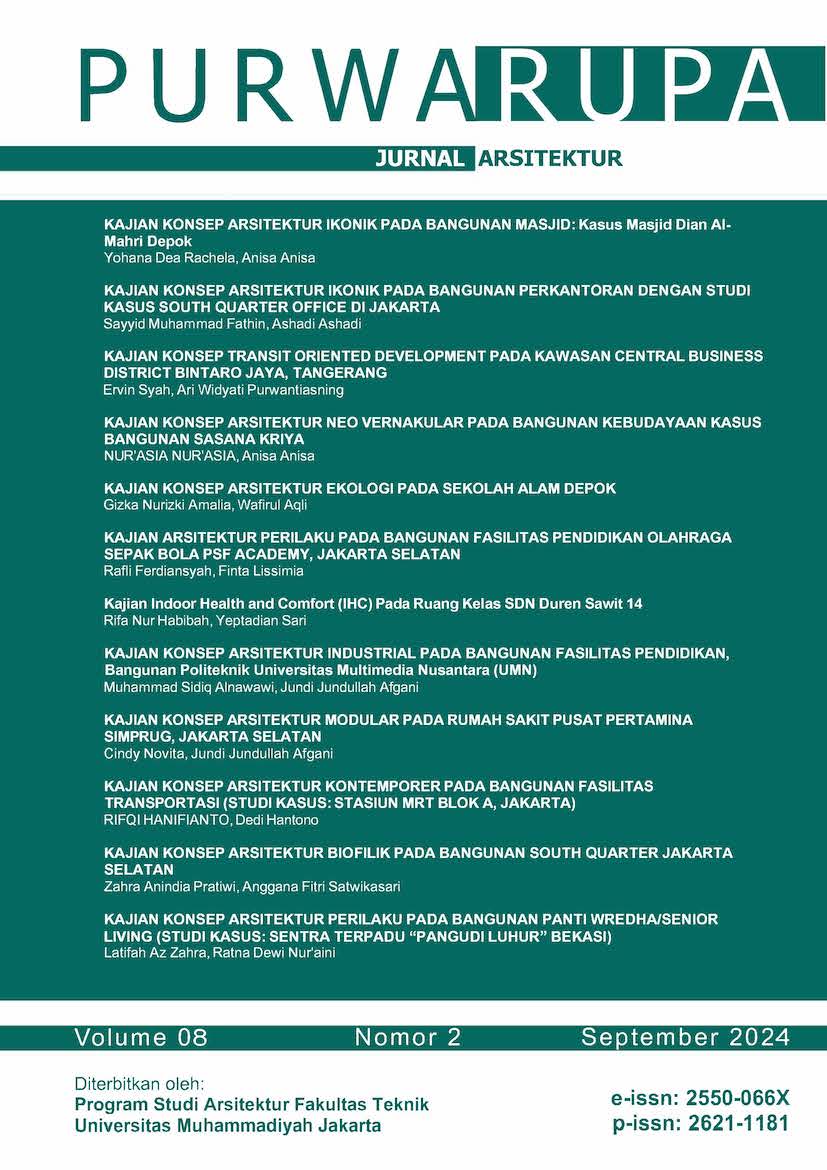KAJIAN KONSEP ARSITEKTUR BIOFILIK PADA BANGUNAN SOUTH QUARTER JAKARTA SELATAN
DOI:
https://doi.org/10.24853/purwarupa.8.2.169-176Abstract
ABSTRAK. Mixed Use Building dengan pendekatan Biofilik merupakan bangunan serbaguna yang mencakup fungsi beragam, termasuk area komersil, hunian, dan pedestarian. Permasalahan serius seperti polusi dan penggunaan energi yang tinggi di Jakarta berdampak signifikan pada kesehatan penghuni. Dengan menerapkan prinsip Biofilik, bangunan menambahkan unsur alam seperti tanaman, menciptakan Kesehatan, produktivitas dan investasi ekonomi untuk kesejateraan pengguna. Tujuan dari penelitian ini adalah untuk mengetahui karakteristik konsep biofilik pada bangunan South Quarter Jakarta Selatan. Metode yang digunakan dalam penelitian ini adalah metode deskriptif kualitatif. Penelitian menunjukan desain bangunan South Quarter berhasil mengintegrasikan tumbuhan alam dan elemen alam dalam desainnya, menciptakan rangsangan langsung dengan alam, serta meningkatkan kenyamanan pengguna melalui desain yang merespon iklim sekitar. Kata Kunci: Arsitektur, Biofilik, Mixed Use ABSTRACT. The Mixed Use Building with a Biofilic approach is a versatile structure that encompasses various functions, including commercial areas, residences, and pedestrian spaces. Serious issues such as pollution and high energy consumption in Jakarta significantly impact the health of residents. By implementing Biofilic principles, the building incorporates natural elements like plants, contributing to health, productivity, and economic investment for the well-being of users. The objective of this research is to understand the characteristics of the biofilic concept in the South Quarter Building in South Jakarta. The method employed in this study is qualitative descriptive. South Quarter has successfully integrated natural plants and elements into its design, creating a direct connection with nature, and enhancing user comfort through a design that responds to the surrounding climate. Keywords: Architectural, Biophilic, Mixed UseReferences
Söderlund, J. (2019). The Emergence of Biofilik Design. Perth, WA, Australia: Sustainability Policy Institute
Azkiawati, L. (2020). KAJIAN KONSEP BIOFILIK PADA BANGUNAN HUNIAN VERTIKAL. Diana Azkiawati; Finta Lissimia, Kajian Konsep Biofilik pada Bangunan Hunian Vertikal .
Savitri esti (2007) indonesiaappartement
Browning, W., Ryan, C.O., & Clancy, J. (2014). 14 Patterns of Biofilik Design: Improving Health and Well-Being in the Built Environment.
Wahidmurni. (2017). Pemaparan Metode Penelitian Kualitatif. UIN Maulana Malik Ibrahim Malang,
Tan PY (2013) Vertical garden city: Singapore. Straits Times Press Pte Ltd, Singapore
Downloads
Published
How to Cite
Issue
Section
License
COPYRIGHT POLICY
The author(s) of an article published in the Jurnal Teknologi retains ownership of the intellectual property rights in work (s).
PUBLISHING RIGHTS
The author(s) of an article published in the Jurnal Teknologi have unrestricted publication rights. The authors give the Jurnal Teknologi the right to publish the article and designate the Faculty of Engineering Universitas Muhammadiyah Jakarta Publishing as the original publisher of the article.
LICENSING POLICY
Journal of Mechanical Engineering and Sciences is an open-access journal that follows the Creative Commons Non-Commercial 4.0 International License (CC BY-NC 4.0), which states that:

Under this license, the reusers must give appropriate credit, provide a link to the license, and indicate if changes were made. Users may do so in any reasonable manner, but not in any way that suggests the licensor endorses users or their use.
Please take the time to read the whole license agreement (https://creativecommons.org/licenses/by-nc/4.0/). As long as reusers follow the license conditions, the owner cannot withdraw these freedoms. The following components are included under this license:
 Attribution: Users must provide appropriate attribution, including a link to the license, and indicate whether or not they made any modifications. Users are free to do so reasonably, but not in a manner that indicates the licensee approves of their usage.
Attribution: Users must provide appropriate attribution, including a link to the license, and indicate whether or not they made any modifications. Users are free to do so reasonably, but not in a manner that indicates the licensee approves of their usage.
 NonCommercial: Users may not use the material for commercial purposes.
NonCommercial: Users may not use the material for commercial purposes.

